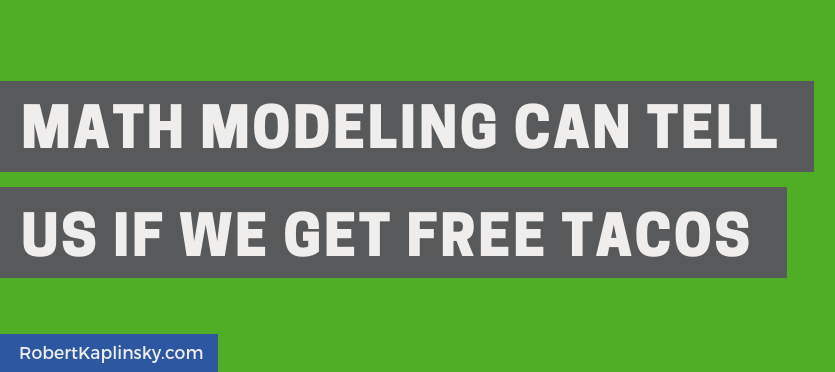[This is one of a series of posts that explore real world examples of mathematical modeling to help educators better understand its applications. This is not intended to be a context for a student lesson. To learn about Spies and Analysts, I recommend watching this webinar (with elementary, middle, and high school versions) or reading this blog post.]
In March 2001, Russia’s Mir space station was falling out of orbit and was going to crash into the Pacific Ocean. Taco Bell used this as an bizarre marketing opportunity and placed a 40′ x 40′ sign in the middle of the ocean with a target on it that said “Free Taco Here!”. If the Mir hit the sign on the way down, everyone in the United States would get free tacos.
Here’s a short video to refresh your memory:
So overall, this is a fairly wild proposition. But I want you to think about this from Taco Bell’s perspective. Sure, they would get great advertising for this stunt (and Mir did not ultimately hit the sign), but what if the space station hit the sign and Taco Bell had to pay up? Would that cost thousands of dollars? Millions? Billions? How would you even figure it out?
What Taco Bell ultimately decided to do was take out an insurance policy from SCA Promotions, a company that guarantees prizes. What this means is that SCA Promotions charged Taco Bell a fee, and if the Mir hit the target, Taco Bell would not have to pay anything more. In fact, Taco Bell was probably hoping and praying that it hit the target as it would have boosted sales and cost them nothing.
Consider though what SCA Promotions had to do to figure out how much to charge Taco Bell. If they charged too much, Taco Bell wouldn’t feel like it was worthwhile. If they charged too little, it wouldn’t be worth the risk to make the deal. If the Mir missed the target, they’d get all the money. If the Mir hit the target, their company could go bankrupt!
So, what if you worked for SCA Promotions and you were asked you to figure out how much to charge Taco Bell for this insurance policy. Where would you begin? What information would you want to know? What would you do with that data once you had access to it? These are the topics I’m exploring in my spies and analysts post. I want to walk you through the process so that you can better appreciate the complexities of mathematical modeling.
The first part of the process requires the spies. So, I want you to stop and take thirty seconds to think about what information you would use to figure out the cost of the insurance policy. Would you look at how how big the sign is? The speed of the Mir? The number of people in the United States? The cost of a taco? The number of people who like tacos? The time of day? As I hope you realize, the list of questions could go on and on. So, think about what information you’d pick if this was your job. Once you’ve determined what information you’d want, keep reading.
- The sign was 40′ by 40′.
- In 2001, there were an estimated 281 million people living in the United States and the cheapest Taco Bell taco cost 60 cents. Taco Bell estimated the cost of the free tacos at $10,000,000. Accordingly, that seems to assume that about 6% of the population would actually take advantage of a free taco.
- According to the video, the area that the Mir was expected to crash into was approximately 3600 miles (5794 km) x 120 miles (193 km) by of the that the Mir
What’s important to realize is that the only solid fact is the size of the sign. The cost of the tacos and the size of the area where the Mir might crash are estimates. That being said, based on the video, it sounds many of the factors I thought of were included. So, how do you take all those factors and turn them into an amount of money to charge Taco Bell?
This is where the analysts come in. Their job is to take the data, figure out what parts are more or less important, and break it down in such a way that it becomes useful. Take 30 more seconds to think about how you might even begin to work with the data.
If that’s the case, then the area of the sign is 1600 square feet while the area of the crash zone is 432,000 square miles. Converting square miles to square feet gives us an area of 12,043,468,800,000 square feet for the crash zone. This results in a ~0.0000000133% (or 1 in 7,500,000,000) chance of hitting the target. So now what? How much do you charge Taco Bell?
The way I see it, a ~0.0000000133% chance of having a $10,000,000 payout leads to an expected value of having to pay $0.001 on average. So, I guess that charging anything over a penny should earn you money over the long run. I don’t know what Taco Bell was actually charged, but with odds like this, I’m surprised that they didn’t just cover the costs themselves.
At this point, there are no computers or calculators that can figure this out on their own. This is where the jobs are at. If we truly want to focus our time and energy in a skill that will really help our students become college and career ready, mathematical modeling is where we need to be.

